Talking Heads
Talking Heads were an American rock band formed in 1975 in New York City and active until 1991.[8] The band was composed of David Byrne (lead vocals, guitar), Chris Frantz (drums), Tina Weymouth (bass), and Jerry Harrison (keyboards, guitar). Described by the critic Stephen Thomas Erlewine as "one of the most critically acclaimed bands of the '80s,"[3] the group helped to pioneer new wave music by integrating elements of punk, art rock, funk, and world music with avant-garde sensibilities and an anxious, clean-cut image.[3]
Talking Heads | |
|---|---|
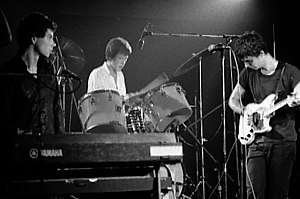 Talking Heads performing at the Horseshoe Tavern in Toronto in 1978 | |
| Background information | |
| Origin | New York City, New York, U.S. |
| Genres | |
| Years active | 1975–1991, 1996, 2002 |
| Labels | |
| Associated acts | |
| Past members | |
Former art school students who became involved in the 1970s New York punk scene, Talking Heads released their 1977 debut album, Talking Heads: 77, to positive reviews.[9] They collaborated with producer Brian Eno on a trio of experimental and critically acclaimed releases: More Songs About Buildings and Food (1978), Fear of Music (1979), and Remain in Light (1980).[3] After a hiatus, Talking Heads hit their commercial peak in 1983 with the U.S. Top 10 hit "Burning Down the House" from the album Speaking in Tongues and released the concert film Stop Making Sense, directed by Jonathan Demme.[3] They released several more albums, including their best-selling LP Little Creatures (1985), before disbanding in 1991.[10]
In 2002, Talking Heads were inducted into the Rock and Roll Hall of Fame. Four of their albums appear in Rolling Stone's list of the 500 Greatest Albums of All Time, and three of their songs ("Psycho Killer", "Life During Wartime", and "Once in a Lifetime") were included among the Rock and Roll Hall of Fame's 500 Songs That Shaped Rock and Roll.[11] Talking Heads were also number 64 on VH1's list of the "100 Greatest Artists of All Time".[12] In the 2011 update of Rolling Stone's "100 Greatest Artists of All Time", they were ranked number 100.[13]
History
1971–1974: Before Talking Heads
From 1971 to 1972, David Byrne was a member of a duo named Bizadi with Marc Kehoe. He performed various offbeat acts and developed an interest in performing. He attended the Rhode Island School of Design in the 1970–1971 term, and the Maryland Institute College of Art in the 1971–1972 term.[14]
Chris Frantz and Tina Weymouth were also alumni of the Rhode Island School of Design in Providence, Rhode Island. There, Byrne and Frantz formed a band called "the Artistics" in 1973.[15] Weymouth was Frantz's girlfriend and often provided transportation for the band. The Artistics dissolved the following year, and the three moved to New York, eventually sharing a communal loft.[16]
1975–1977: The early years
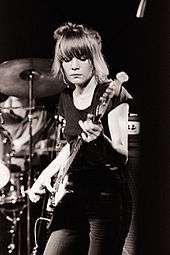
Tina Weymouth became the band's bass player after they were unable to find one in New York City. Frantz encouraged Weymouth to learn to play bass by listening to Suzi Quatro albums.[17] They played their first gig as "Talking Heads" opening for the Ramones at CBGB on June 5, 1975.[8]
In a later interview, Weymouth recalled how the group chose the name Talking Heads: "A friend had found the name in the TV Guide, which explained the term used by TV studios to describe a head-and-shoulder shot of a person talking as 'all content, no action'. It fit."[18] Later that year, the trio recorded a series of demos for CBS, but the band was not signed to the label. The band quickly drew a following and was signed to Sire Records in November 1976. They released their first single in February the following year, "Love → Building on Fire". In March 1977, they added Jerry Harrison, formerly of Jonathan Richman's band the Modern Lovers, on keyboards, guitar, and backing vocals.[19] During this time, Byrne asked Weymouth to audition three more times to keep her place in the band.[20]
The first Talking Heads album, Talking Heads: 77, received acclaim and produced their first charted single, "Psycho Killer".[21] Many connected the song to the serial killer known as the Son of Sam, who had been terrorizing New York City months earlier; however, Byrne said he had written the song years prior.[22]
1978–1980: Collaborations with Eno
More Songs About Buildings and Food (1978) was Talking Heads' first collaboration with producer Brian Eno, who had previously worked with Roxy Music, David Bowie, John Cale and Robert Fripp;[23] the title of Eno's 1977 song "King's Lead Hat" is an anagram of the band's name. Eno's unusual style meshed well with the group's artistic sensibilities, and they began to explore an increasingly diverse range of musical directions, from post-punk to psychedelic funk to African music.[2][24][7] This recording also established the band's relationship with Compass Point Studios in Nassau, Bahamas. More Songs About Buildings and Food included a cover of Al Green's "Take Me to the River." This broke Talking Heads into the general public's consciousness and gave the band their first Billboard Top 30 hit.[7]
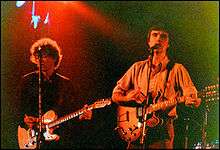
The Eno–Talking Heads experimentation continued with 1979's Fear of Music, which flirted with the darker stylings of post-punk rock, mixed with white funkadelia and subliminal references to the geopolitical instability of the late 1970s.[7] Music journalist Simon Reynolds cited Fear of Music as representing the Eno-Talking Heads collaboration "at its most mutually fruitful and equitable".[25] The single "Life During Wartime" produced the catchphrase "This ain't no party, this ain't no disco."[26] The song refers to the Mudd Club and CBGB, two popular New York nightclubs of the time.[27]
Remain in Light (1980) was heavily influenced by the afrobeat of Nigerian bandleader Fela Kuti, whose music Eno had introduced to the band. It explored West African polyrhythms, weaving these together with Arabic music from North Africa, disco funk, and "found" voices.[28] These combinations foreshadowed Byrne's later interest in world music.[29] In order to perform these more complex arrangements, the band toured with an expanded group, including Adrian Belew and Bernie Worrell, among others, first at the Heatwave festival in August,[30] and later in their concert film Stop Making Sense. During this period, Tina Weymouth and Chris Frantz also formed a commercially successful splinter group, Tom Tom Club, influenced by the foundational elements of hip hop,[31] and Harrison released his first solo album, The Red and the Black.[32] Likewise, Byrne—in collaboration with Eno—released My Life in the Bush of Ghosts, which incorporated world music and found sounds, as well as including a number of other prominent international and post-punk musicians.[33] All were released by Sire.

Remain in Light's lead single, "Once in a Lifetime", became a Top 20 hit in the UK, but initially failed to make an impression in the USA. It grew into a popular standard over the next few years on the strength of its music video, which was named one of Time's All-TIME Best Music Videos.[35][36]
1981–1991: Commercial peak and breakup
After releasing four albums in barely four years, the group went into hiatus, and nearly three years passed before their next release, although Frantz and Weymouth continued to record with the Tom Tom Club. In the meantime, Talking Heads released a live album The Name of This Band Is Talking Heads, toured the United States and Europe as an eight-piece group, and parted ways with Eno,[37] who went on to produce albums with U2.[23]
1983 saw the release of Speaking in Tongues, a commercial breakthrough that produced the band's only American Top 10 hit, "Burning Down the House".[38] Once again, a striking video was inescapable owing to its heavy rotation on MTV.[39] The following tour was documented in Jonathan Demme's Stop Making Sense, which generated another live album of the same name.[40] The tour in support of Speaking in Tongues was their last.[41]
David Byrne, interviewing himself in Stop Making Sense[42]
Three more albums followed: 1985's Little Creatures (which featured the hit singles "And She Was" and "Road to Nowhere"),[43] 1986's True Stories (Talking Heads covering all the soundtrack songs of Byrne's musical comedy film, in which the band also appeared),[44] and 1988's Naked. Little Creatures offered a much more American pop-rock sound as opposed to previous efforts.[45] Similar in genre, True Stories hatched one of the group's most successful hits, "Wild Wild Life", and the accordion-driven track "Radio Head", which became the etymon of the band of the same name.[46] Naked explored politics, sex, and death, and showed heavy African influence with polyrhythmic styles like those seen on Remain in Light.[47] During that time, the group was falling increasingly under David Byrne's control and, after Naked, the band went on "hiatus".[3] In 1987 Talking Heads released a book by called What the Songs Look Like : Contemporary Artists Interpret Talking Heads Songs with Harper Collins that contained artwork by some of the top New York visual artists of the decade.

It took until December 1991 for an official announcement to be made that Talking Heads had broken up.[3] On the break-up, Frantz said "We were shocked to find out about [Byrne's departure] via the Los Angeles Times. As far as we're concerned, the band never really broke up. David just decided to leave." [48] Their final release was "Sax and Violins", an original song that had appeared earlier that year on the soundtrack to Wim Wenders' Until the End of the World. During this breakup period, Byrne continued his solo career, releasing Rei Momo in 1989 and The Forest in 1991.[29] This period also saw a revived flourish from both Tom Tom Club (Boom Boom Chi Boom Boom and Dark Sneak Love Action)[49] and Harrison (Casual Gods and Walk on Water), who toured together in the summer of 1990.[50]
1992–2002: Post-break-up and final reunion
Despite David Byrne's lack of interest in another album, Tina Weymouth, Chris Frantz, and Jerry Harrison reunited for a one-off album called No Talking, Just Head under the name The Heads in 1996. The album featured a number of vocalists, including Debbie Harry of Blondie, Johnette Napolitano of Concrete Blonde, Andy Partridge of XTC, Gordon Gano of Violent Femmes, Michael Hutchence of INXS, Ed Kowalczyk of Live, Shaun Ryder of Happy Mondays, Richard Hell, and Maria McKee.[51] The album was accompanied by a tour, which featured Johnette Napolitano as the vocalist. Byrne took legal action against the rest of the band to prevent them using the name "Talking Heads", something he saw as "a pretty obvious attempt to cash in on the Talking Heads name".[52] They opted to record and tour as "The Heads". Likewise, Byrne continued his solo career.
Meanwhile, Harrison became a record producer of some note – his résumé includes the Violent Femmes' The Blind Leading the Naked, the Fine Young Cannibals' The Raw and the Cooked, General Public's Rub It Better, Crash Test Dummies' God Shuffled His Feet, Live's Mental Jewelry, Throwing Copper and The Distance to Here, No Doubt's song "New" from Return of Saturn, and in 2010, work by The Black and White Years and Kenny Wayne Shepherd.[53]
Frantz and Weymouth, who married in 1977,[54] had been recording on the side as Tom Tom Club since 1981.[31] Tom Tom Club's self-titled debut album sold almost as well as Talking Heads themselves,[55] leading to the band appearing in Stop Making Sense. They achieved several pop/rap hits during the dance-club cultural boom era of the early 1980s,[56] particularly in the UK, where they still enjoy a strong fan following today. Their best-known single, "Genius of Love", has been sampled numerous times, notably on old school hip hop classic "It's Nasty (Genius of Love)" by Grandmaster Flash and on Mariah Carey's 1995 hit "Fantasy".[57] They also have produced several artists, including Happy Mondays and Ziggy Marley. The Tom Tom Club continue to record and tour intermittently, although commercial releases have become sporadic since 1991.[55]
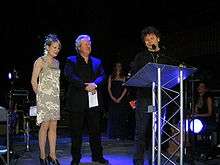
The band played "Life During Wartime", "Psycho Killer", and "Burning Down the House" together on March 18, 2002, at the ceremony of their induction into the Rock and Roll Hall of Fame, joined on stage by former touring members Bernie Worrell and Steve Scales.[58] However, reuniting for a concert tour is unlikely. David Byrne states: "We did have a lot of bad blood go down. That's one reason, and another is that musically we're just miles apart."[59] Weymouth, however, has been critical of Byrne, describing him as "a man incapable of returning friendship"[59] and saying that he doesn't "love" her, Frantz, and Harrison.[17]
Influence
AllMusic stated that Talking Heads, one of the most celebrated bands of the 1970s and 1980s,[3] by their breakup "had recorded everything from art-funk to polyrhythmic worldbeat explorations and simple, melodic guitar pop".[3] Talking Heads' art pop innovations have had a long-lasting impact.[60] Along with other groups such as Devo, Ramones and Blondie, they helped define the new wave genre in the United States.[61] Meanwhile, the more worldly popularities like 1980's Remain in Light helped bring African rock to the western world.[62]
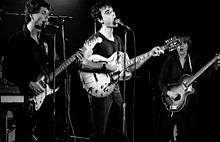
Talking Heads have been cited as an influence by many artists, including Eddie Vedder,[63] Foals,[64] The Weeknd,[65] Vampire Weekend,[66] Primus,[67] Bell X1,[68] The 1975,[69] The Ting Tings,[70] Nelly Furtado,[71] Kesha,[72] St. Vincent,[73] and Radiohead, who took their name from the Talking Heads song "Radio Head" from the 1986 album True Stories.[74][75] The Italian filmmaker and director Paolo Sorrentino, in receiving the Oscar for his film La Grande Bellezza in 2014, thanked Talking Heads, among others, as his sources of inspiration.[76]
Members
- David Byrne – lead vocals, guitar (1975–91)
- Chris Frantz – drums, backing vocals (1975–91)
- Tina Weymouth – bass, backing vocals (1975–91)
- Jerry Harrison – keyboards, guitar, backing vocals (1977–91)
Touring musicians
- Adrian Belew – lead guitar, vocals (1980–1981)
- Alex Weir – guitar, vocals (1983–1984)
- Bernie Worrell – keyboards, backing vocals (1980–1984)
- Busta Jones – bass (1980–1981)
- Steve Scales – percussion, backing vocals (1980–1984)
- Dolette McDonald – vocals, cowbell (1980–1981)
- Ednah Holt – vocals (1983–1984)
- Lynn Mabry – vocals (1983–1984)
- Nona Hendryx – vocals (1980)
Discography
- Talking Heads: 77 (1977)
- More Songs About Buildings and Food (1978)
- Fear of Music (1979)
- Remain in Light (1980)
- Speaking in Tongues (1983)
- Little Creatures (1985)
- True Stories (1986)
- Naked (1988)
See also
- List of dance-rock artists
- List of funk rock bands
- List of new wave artists and bands
- List of post-punk bands
References
- Cateforis, Theo (2011). Are We Not New Wave? : Modern Pop at the Turn of the 1980s. University of Michigan Press. pp. 2, 43, 73. ISBN 0-472-03470-7.
- Ricchini, William (November 12, 1996). "Napolitano Brings Out Best Of Heads". The Philadelphia Inquirer. Retrieved April 24, 2015.
- Erlewine, Stephen Thomas. "Talking Heads: Biography". AllMusic. Retrieved April 27, 2014.
- Jack, Malcolm (September 21, 2016). "Talking Heads – 10 of the best". The Guardian.
- Holden, Stephen (February 28, 1999). "MUSIC; They're Recording, but Are They Artists?". The New York Times. Retrieved July 17, 2013.
- Marks, Craig; Weisbard, Eric (1995). Spin Alternative Record Guide. Vintage Books.
- Simon Reynolds. Rip It up and Start Again: Postpunk 1978–1984. Penguin Books (2005) p. 163.
- Talking Heads Rock and Roll Hall of Fame, retrieved November 23, 2008
- Demorest, Stephen; Demorest, Stephen (November 3, 1977). "Talking Heads '77". Rolling Stone. Retrieved August 3, 2019.
- Talking Heads. Encyclopædia Britannica.
- "Archived copy". Archived from the original on March 17, 2010. Retrieved January 12, 2008.CS1 maint: archived copy as title (link)
- "The Greatest – Ep. 215". vh1.com. Retrieved April 29, 2015.
- "100 Greatest Artists of All Time". Rolling Stone. 2011. Retrieved January 8, 2016.
- Byrne, David, How Music Works, Three Rivers Press, 2017, ISBN 0-804-18893-9, ISBN 978-0804188937
- Gittins, Ian, Talking Heads: Once in a Lifetime : the Stories Behind Every Song, Hal Leonard Corporation, 2004, p. 140. ISBN 0-634-08033-4, ISBN 978-0-634-08033-3.
- Simon Reynolds. Rip It up and Start Again: Postpunk 1978–1984. Penguin Books (2005) p. 159.
- Tina Talks Heads, Tom Toms, and How to Succeed at Bass Without Really Trying Gregory Isola, Bass Player, retrieved December 6, 2008.
- Weymouth, Tina (1992). In Sand in the Vaseline. CD liner notes, p. 12. New York: Sire Records Company
- Greene, Andy. "Flashback: Talking Heads Perform 'Psycho Killer' at CBGB in 1975". Rolling Stone. Retrieved April 23, 2014.
- Courogen, Carrie (September 15, 2017). "40 Years Later, Talking Heads' Most Valuable Member Is Still Its Most Under-Recognized". PAPER. Retrieved September 26, 2018.
- Ruhlmann, William. "Talking Heads 77". AllMusic. Retrieved April 23, 2014.
- Ian Gittins (2004). Talking Heads: Once in a Lifetime: The Stories Behind Every Song. Hal Leonard. p. 30. ISBN 978-0-634-08033-3.
- "Brian Eno | Credits". Allmusic. Retrieved April 25, 2014.
- Pilchak, Angela M. (2005). Contemporary Musicians. 49. Gale. p. 77. ISBN 978-0-7876-8062-6.
- Simon Reynolds. Rip It up and Start Again: Postpunk 1978–1984. Penguin Books (2005) pp. 163–164.
- Janovitz, Bill. "Life During Wartime – Song Review". Allmusic. Retrieved April 25, 2014.
- Robbins, Ira. "20 Years Later, CBGB Ain't No Disco : Clubs: A look back as the Bowery bar concludes a monthlong celebration of its commitment to underground rock's trends". Los Angeles Times. Retrieved April 25, 2014.
- Simon Reynolds. Rip It up and Start Again: Postpunk 1978–1984. Penguin Books (2005) p. 165.
- Ankeny, Jason. "David Byrne | Biography". Allmusic. Retrieved April 25, 2014.
- Robins, Jim (September 6, 1980). "Expanded Talking Heads Climax Canadian New Wave Festival". The Michigan Daily.
- Boehm, Mike (September 10, 1992). "x-Heads Say They Got Byrned: Split Still Miffs Frantz, Weymouth, Even Though Tom Tom Club Keeps Them Busy". Los Angeles Times.
- Palmer, Robert (November 18, 1981). "The Pop Life". The New York Times.
- Bush, John. "My Life in the Bush of Ghosts". Allmusic. Retrieved April 25, 2014.
- "The 100 most important American musical works of the 20th century". NPR. Retrieved May 5, 2014.
- Simon Reynolds. Rip It up and Start Again: Postpunk 1978–1984. Penguin Books (2005) p. 169.
- Sanburn, Josh. "The 30 All-TIME Best Music Videos". Time. Retrieved May 5, 2014.
- Simon Reynolds. Rip It up and Start Again: Postpunk 1978–1984. Penguin Books (2005) pp. 169–170.
- DeGagne, Mike. "Burning Down the House – Talking Heads – Song Review". Allmusic. Retrieved April 25, 2014.
- Johnston, Maura. "Sick Of It All (16) Battles Talking Heads (8) As SOTC's March Madness Takes A Trip To CBGB". Village Voice. Retrieved April 25, 2014.
- Light, Alan. "All-TIME 100 Albums". Time. Retrieved April 25, 2014.
- Milward, John. "The Many Faces And Artistic Endeavors Of The Talking Heads David Byrne And His Mates In The Band Are Keeping Busy – Together, With "Naked," And On Their Own". Philly.com. Retrieved April 25, 2014.
- Harvey, Eric. "David Byrne: Live From Austin TX". Pitchfork Media. Retrieved May 5, 2014.
- "Little Creatures – Talking Heads". Allmusic. Retrieved April 27, 2014.
- Maslin, Janet. "True Stories (1986) DAVID BYRNE IN 'TRUE STORIES'". The New York Times. Retrieved April 27, 2014.
- Ruhlmann, William. "Little Creatures". Allmusic. Retrieved April 27, 2014.
- Hastings, Michael. "Talking Heads – True Stories". Allmusic. Retrieved April 27, 2014.
- Pareles, Jon (March 20, 1988). "Talking Heads get 'Naked'". Observer-Reporter.
- Boehm, Mike (September 10, 1992). "x-Heads Say They Got Byrned: Split Still Miffs Frantz, Weymouth, Even Though Tom Tom Club Keeps Them Busy". Los Angeles Times.
- Ruhlmann, William. "Tom Tom Club | Biography". Allmusic. Retrieved April 27, 2014.
- Christensen, Thor (May 22, 1990). "Harrison starts to find own voice". The Milwaukee Journal.
- Erlewine, Stephen Thomas. "No Talking Just Head – The Heads". Allmusic. Retrieved May 1, 2014.
- Levine, Robert (June 26, 1997). "Byrne-ing Down the House". Rolling Stone. DavidByrne.com. Retrieved October 31, 2009.
- "Jerry Harrison | Credits". Allmusic. Retrieved May 1, 2014.
- Clarke, John. "Rockers Chris Frantz and Tina Weymouth Talk Marriage". Rolling Stone. Retrieved May 1, 2014.
- Ruhlmann, William. "Tom Tom Club – Biography". Allmusic. Retrieved May 4, 2014.
- "Tom Tom Club – Awards". Allmusic. Retrieved May 4, 2014.
- Greenberg, Rudi (June 2, 2011). "Geniuses of Survival: Tom Tom Club, at Ram's Head On Stage". Washington Post. Retrieved May 4, 2014.
- Greene, Andy. "23 October 2012". Rolling Stone. Retrieved May 4, 2014.
- Blackman, Guy (February 6, 2005). "Byrning down the house". The Age. Australia. Retrieved October 3, 2009.
- allmusic.com Retrieved July 5, 2015.
- Gendron, Bernard. "Origins of the First Wave: The CBGB Scene (1974–75)". Between Montmartre and the Mudd Club: Popular Music and the Avant-Garde. University of Chicago Press. Retrieved May 11, 2014.
- Pareles, Jon (November 8, 1988). "Review/Music; How African Rock Won the West, And on the Way Was Westernized". New York Times. Retrieved May 11, 2014.
- SPIN staff (July 15, 2003). "My Life in Music: Eddie Vedder". SPIN.
- "Foals Total Life Forever Review". BBC. Retrieved November 15, 2013.
- Calum Slingerland (February 6, 2016). "The Weeknd's New Album Is Inspired by Bad Brains, Talking Heads and the Smiths". Exclaim!. Retrieved September 6, 2016.
- Burrows, Tim (May 8, 2008). "Vampire Weekend: fresh blood on campus". The Daily Telegraph. Retrieved May 11, 2014.
- Primus press release. Retrieved August 12, 2012.
- Matthew Magee (July 27, 2003). "Clear as a Bell X1". Sunday Tribune. Archived from the original on July 21, 2011. Retrieved March 4, 2011.
- Faughey, Darragh (December 11, 2012). "The 1975 – Interview". GoldenPlec. Retrieved February 11, 2016.
- Walden, Eric (March 27, 2015). "Concert preview: Ting Tings feeling a bit less 'Super Critical' now". The Salt Lake Tribune. Retrieved November 27, 2015.
- "NELLY FURTADO – Loose – The Story". Universal Music. Archived from the original on October 3, 2015. Retrieved December 2, 2015.
- Garland, Emma (January 8, 2017). "Kesha's MySpace Profile from 2008 is Better Than DJ Khaled's Snapchat". Noisey. Vice Media. Retrieved January 20, 2017.
- Graves, Shahlin (May 26, 2012). "Interview: ANNIE CLARK a.k.a. ST. VINCENT on 'Strange Mercy'". www.coupdemainmagazine.com. Archived from the original on February 7, 2013. Retrieved March 25, 2017.
- About Radiohead, biography 1992–1995
- David Byrne interviews Thom Yorke for Wired (November 11, 2007)
- Vivarelli, Nick. "Italy Cheers Foreign Oscar Victory For Paolo Sorrentino's 'Beauty'". Variety. Retrieved May 4, 2014.
Further reading
- David Bowman, This Must Be the Place: The Adventures of Talking Heads in the Twentieth Century (New York: HarperCollins, 2001). ISBN 0-380-97846-6.
- David Byrne, How Music Works (San Francisco: McSweeney's, 2012). ISBN 1-936365-53-7.
- David Gans, Talking Heads (New York: Avon Books, 1985). ISBN 0-380-89954-X.
- Krista Reese, The Name of This Book is Talking Heads (London: Proteus Books, 1982). ISBN 0-86276-057-7.
- Sytze Steenstra, Song and Circumstance: The Work of David Byrne from Talking Heads to the Present (New York and London: Continuum Books, 2010). ISBN 978-08264-4168-3.
- Talking Heads and Frank Olinsky, What the Songs Look Like: Contemporary Artists Interpret Talking Heads Songs (New York: Harper & Row, 1987). ISBN 0-06-096205-4.
- Wilcox, Tyler (October 3, 2016). "Talking Heads' Road to Remain in Light". Pitchfork.